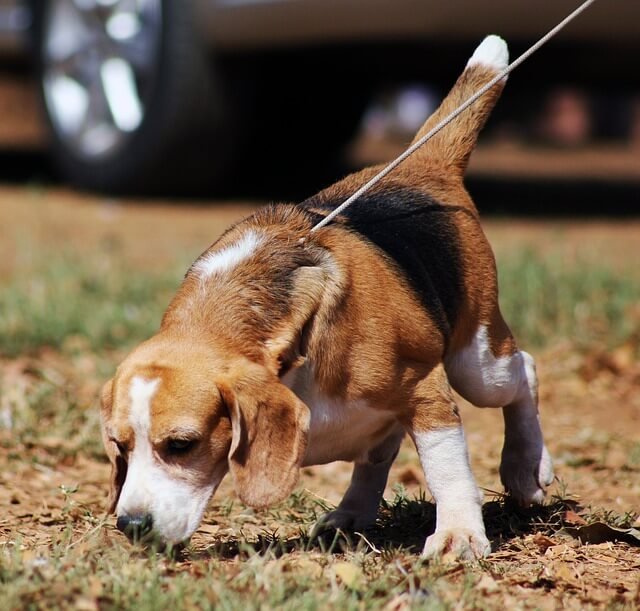If you have a dog who prefers to pee inside the house rather than outside, you might be feeling frustrated and confused. Why does your dog do this? Why does your Dog Refuses to Pee Outside? And how can you teach him to go outside?
There are many possible reasons why a dog might refuse to pee outside, and some of them might require medical attention. Here are some of the most common causes and what you can do to help your dog.
Causes of Dog Refuses to Pee Outside
Health Problems
Some health problems can make your dog feel an urgent and frequent need to pee or make it difficult for him to control his bladder. These include:
- Urinary tract infections (UTIs): A UTI can cause pain, inflammation, and blood in the urine. Your dog might pee more often, or in small amounts. A UTI can be diagnosed by your vet and treated with antibiotics.
- Arthritis: Arthritis can cause joint pain and stiffness, especially in older dogs. Your dog might have trouble going up or down the stairs or walking on uneven surfaces. He might also avoid going outside when it’s cold or wet. Your vet can prescribe painkillers and anti-inflammatory drugs to ease your dog’s discomfort.
- Incontinence: Incontinence is the loss of bladder control, which can happen to older dogs or female dogs after spaying. Your dog might leak urine when he sleeps, or dribble urine when he walks. Your vet can prescribe medication or hormone therapy to help your dog regain bladder control.
- Diabetes or kidney problems: Diabetes or kidney problems can affect your dog’s water balance and metabolism. Your dog might drink more water, and pee more often. He might also lose weight, have a poor appetite, or vomit. Your vet can diagnose these conditions with blood tests and urine tests, and prescribe medication or diet changes to manage them.
- Cognitive dysfunction (doggie dementia): Cognitive dysfunction is a decline in mental function that can affect older dogs. Your dog might forget where he is supposed to pee or get confused about his surroundings. He might also show signs of anxiety, depression, or aggression. Your vet can prescribe medication or supplements to improve your dog’s cognitive function.
If your dog has any of these health problems, it’s important to take him to the vet as soon as possible. Some of these conditions can be serious or life-threatening if left untreated. Your vet can also advise you on how to manage your dog’s symptoms and prevent accidents at home.
Fear or Anxiety
Some dogs might be afraid or anxious about something outside, and that’s why Dog Refuses to Pee Outside. This could be due to:

- Past trauma: If your dog was abused, neglected, or punished for peeing indoors in the past, he might be scared to pee in front of humans. He might also associate peeing outside with something bad, such as loud noises, other dogs, or strangers.
- Lack of socialization: If your dog was not exposed to different environments, people, and animals when he was a puppy, he might be fearful of new situations. He might not feel comfortable peeing outside if there are unfamiliar sights, sounds, or smells.
- Separation anxiety: If your dog has separation anxiety, he might feel stressed when you leave him alone at home. He might pee inside the house as a way of coping with his anxiety or as a way of marking his territory.
If your dog is afraid or anxious about peeing outside, you need to help him overcome his fears and build his confidence. Here are some tips:
- Be patient and gentle: Don’t scold, yell at, or hit your dog for peeing inside the house. This will only make him more fearful and anxious. Instead, praise him and reward him with treats when he pees outside.
- Create a safe space: Choose a quiet and secluded spot for your dog to pee outside, away from distractions and potential threats. You can also use a crate or a pen to create a safe space for your dog inside the house.
- Gradually expose him to new stimuli: If your dog is afraid of something outside, such as cars, people, or other dogs, you can gradually expose him to these stimuli using positive reinforcement. For example, you can start by taking him for short walks near your house, and reward him with treats and praise when he pees outside. Then, you can gradually increase the distance and duration of the walks, and introduce him to new places and people.
- Seek professional help: If your dog’s fear or anxiety is severe or persistent, you might need to consult a professional dog trainer or behaviorist. They can help you identify the root cause of your dog’s problem, and design a customized training plan to help your dog overcome it.

Poor House-Training
Some Dog Refuses to Pee Outside simply because they don’t know any better. They might not have been properly house-trained, or they might have learned bad habits from their previous owners. Some of the factors that can contribute to poor house training are:
- Inconsistent rules: If you don’t have clear and consistent rules for your dog about where he can and can’t pee, he might get confused and pee wherever he wants. For example, if you sometimes let him pee on the carpet or on pee pads, he might not understand why he can’t do it all the time.
- Lack of supervision: If you don’t watch your dog closely when he is inside the house, he might sneak off and pee in a hidden spot. He might also not get enough opportunities to go outside, especially if you have a busy schedule or a small apartment.
- Lack of communication: If you don’t pay attention to your dog’s signals when he needs to pee, such as sniffing, circling, or whining, he might not be able to hold it until you take him outside. He might also not know how to ask you to let him out, or how to use a bell or a door.
If your dog is not well house-trained, you need to teach him the basic rules and expectations of peeing outside. Here are some steps:
- Establish a routine: Set a regular schedule for your dog’s meals, walks, and potty breaks. Try to take him outside at least every 2 to 4 hours, depending on his age and size. Also, take him outside first thing in the morning, last thing at night, and after meals, naps, and playtime.
- Supervise him closely: Keep your dog in your sight when he is inside the house, or confine him to a crate or a pen when you can’t watch him. This will prevent him from peeing in inappropriate places, and allow you to catch him in the act if he tries.
- Use cues and rewards: Teach your dog a cue word or phrase, such as “go potty” or “do your business”, that you can use when you take him outside. When he pees outside, praise him and reward him with treats. This will help him associate peeing outside with something positive.
- Clean-up accidents: If your dog pees inside the house, clean up the mess as soon as possible with an enzyme-based cleaner. This will remove the odor and prevent your dog from being attracted to the same spot again.

FAQ
How do I get my stubborn dog to pee outside?
Consistency is key when it comes to training your dog to pee outside. Set a routine by taking your dog out at consistent times each day, such as in the morning, after meals, and before bedtime. During potty breaks, allow your dog ample time to explore and find the ideal spot while encouraging them to sniff around. By following this approach, you can establish a reliable routine that helps your dog understand when and where to relieve themselves outside.
How hard is it to train a dog to pee outside?
House training a dog, regardless of age, can be achieved with patience, consistency, and empathy. When you notice your dog starting to pee indoors, act swiftly by taking them outside without delay. With consistent and immediate redirection, your dog will gradually learn to associate going outside with relieving themselves. Remember, house training requires time and understanding, but by implementing these techniques, you can teach your dog to wait and establish good bathroom habits.
How long should you wait outside for your dog to pee?
10-15 minutes.
When potty training a young puppy, it can be helpful to offer another opportunity for them to relieve themselves outside if they haven’t done so during the first trip. After waiting for about 10 to 15 minutes, take your puppy outside again. If they still don’t go within 1 to 2 minutes, bring them back indoors. Wait for another 10 to 15 minutes before attempting another outdoor trip. This approach allows for multiple chances for your puppy to eliminate outside while also preventing unnecessary delays in their potty training progress.
Conclusion
When your Dog Refuses to Pee Outside it can be frustrating and stressful for both you and your dog. But with patience, understanding, and proper training, you can help your dog overcome this problem and enjoy a happy and healthy life together.

